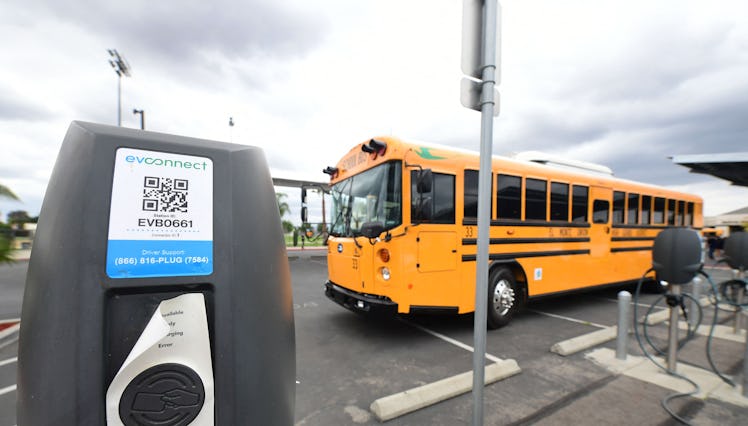EPA’s Clean School Bus Program Awards 400 Districts New Electric Buses. It’s Just The Beginning.
Kids across the U.S. will breathe cleaner air thanks to a new EPA and Biden administration initiative that is only just getting started.

Thanks to a new Biden Administration program, the number of diesel-guzzling and exhaust-belching school buses on the road is set to decrease drastically over the coming years. In their place, electric school buses will take to the roads and get our kids to school. And although it will take five years to overhaul our school bus system, the first round of school districts to receive upgraded electric school buses has been announced. In 389 school districts spanning all 50 states, as well as several Tribal nations and U.S. territories, schools will receive low-emission electric buses that will cut down on both air pollution and noise pollution.
How significant is this program? Very. School buses are the most extensive public transportation network in the country — with more than half a million school buses traveling over six billion miles a year. And right now, 95% of school buses are running on diesel fuel.
The vehicle upgrades are part of the Environmental Protection Agency’s 2022 Clean School Bus Program rebate competition. $500 million was set aside when the program was initially announced in May, and the EPA nearly doubled the amount of available funding to $965 million due to an overwhelming response from schools across the country.
School districts were selected via a weighted lottery system that prioritized districts serving marginalized and at-risk communities. In this first round of funding, 99% of the districts selected are identified as priority areas benefitting low-income, rural, and/or tribal students.
In addition to the general environmental benefits of replacing more than 2,400 diesel buses with electric buses, the Clean School Bus Program also aims to address health disparities through its targeted rollout. The vast majority of requested school buses were electric, though a few were new diesel requests as well.
“Diesel air pollution is linked to asthma and other conditions that harm students' health and cause them to miss school, particularly in communities of color and Tribal communities,” the EPA said in a release. “The program also delivers on President Biden's Justice40 Initiative, which aims to deliver 40% of the overall benefits of certain federal investments to disadvantaged communities that are marginalized, underserved, and overburdened by pollution.”
Previous reporting from Fatherly found that diesel is 3,200 times more harmful to the climate than carbon dioxide in the short term. And one estimate found that kids who ride older diesel school buses with no pollution control are at a 4% higher risk of developing cancer over the course of their lives. The White House has indicated that this bus replacement program could eliminate 2,000 deaths per year, at least 18,000 cases of childhood asthma, and 1.1 million missed days of school per year — just by getting rid of diesel buses.
“We expect to see a significant drop in cases of asthma and other respiratory illnesses in kids and bus drivers and teachers who load our precious cargo before and after school,” EPA Administrator Michael Regan told Fatherly previously. “These electric school buses could eliminate that anxiety of having an asthma attack on the way to school or some sort of respiratory distress.”
In addition to funding for electric school buses — which can cost close to $400,000 each — school districts will be provided with funding for essential infrastructure elements such as charging stations for their new fleets.
The federal government isn’t just focused on school buses. It’s also hard at work electrifying the USPS fleet — another massive federal fleet of vehicles — to better serve our environment.
Did your school district get a new electric bus? Check out this list to see which 389 school districts were awarded new school buses, and how many school buses those school districts will receive with the first round of funding.
And there’s still hope for schools that missed out on this round of funding for new school buses as these awards account for only about 20% of the $5 billion set aside in the Infrastructure Investment and Jobs Act that was signed into law in November 2021.
There’s currently a waitlist of districts that may still receive buses this year in the event that the allocated $965 million isn’t fully used by the schools whose proposals have already been accepted. And the EPA will make another $1 billion available for clean school buses in the fiscal year 2023, opening the door for even more districts to receive funding for cleaner and quieter rides.